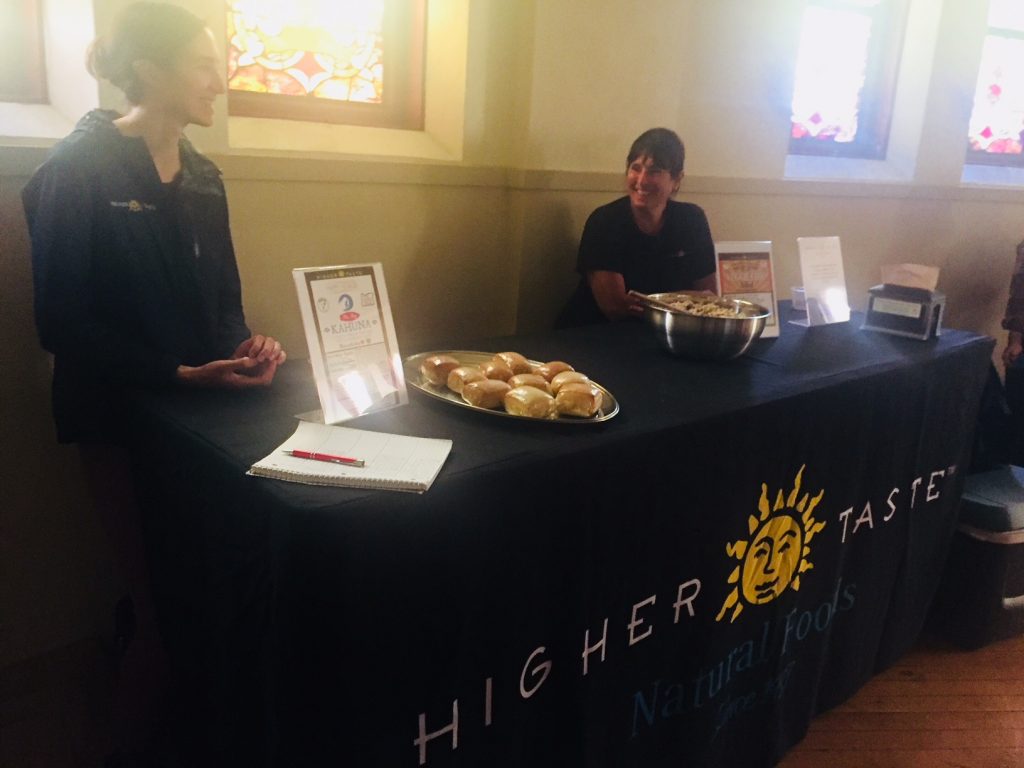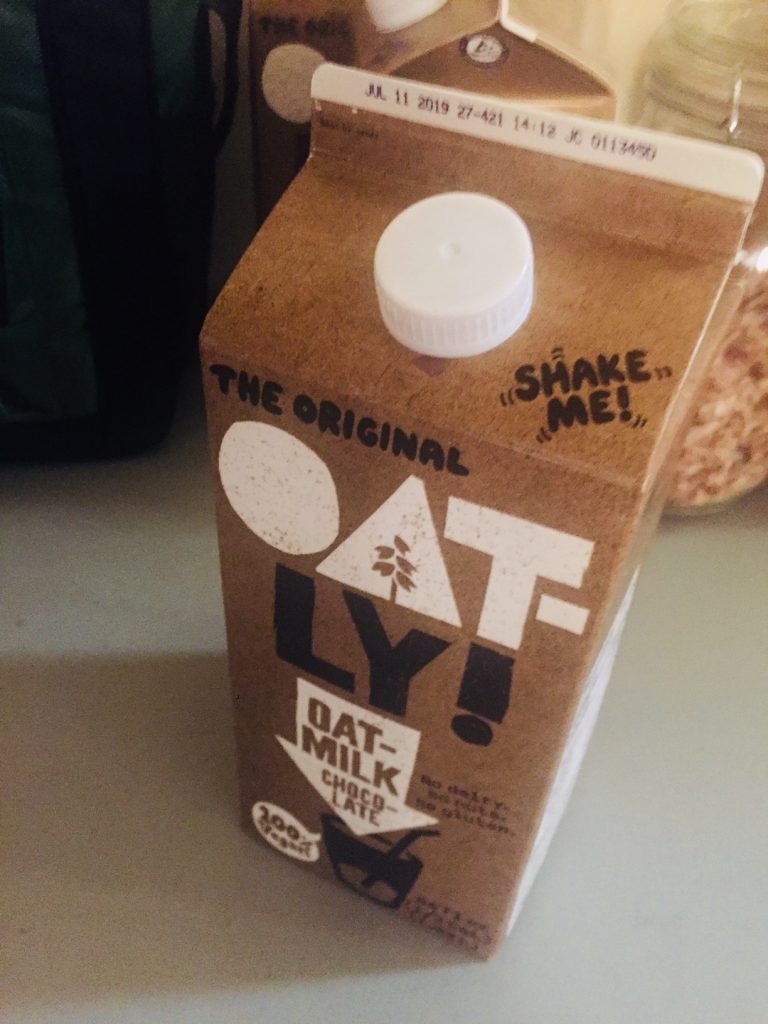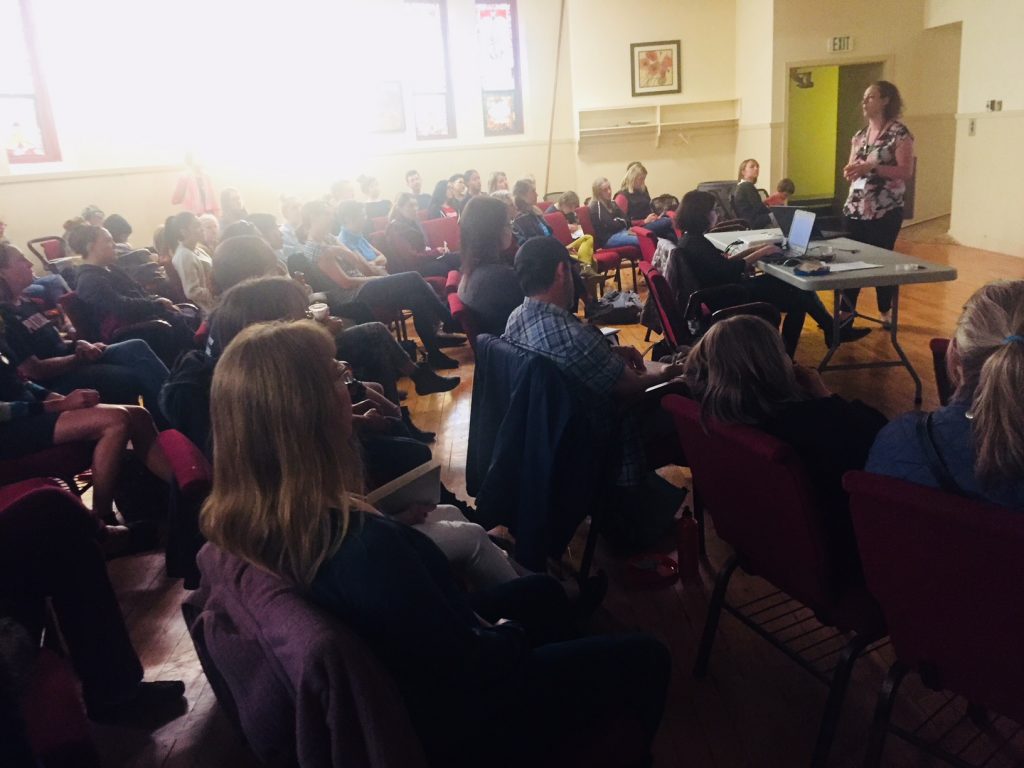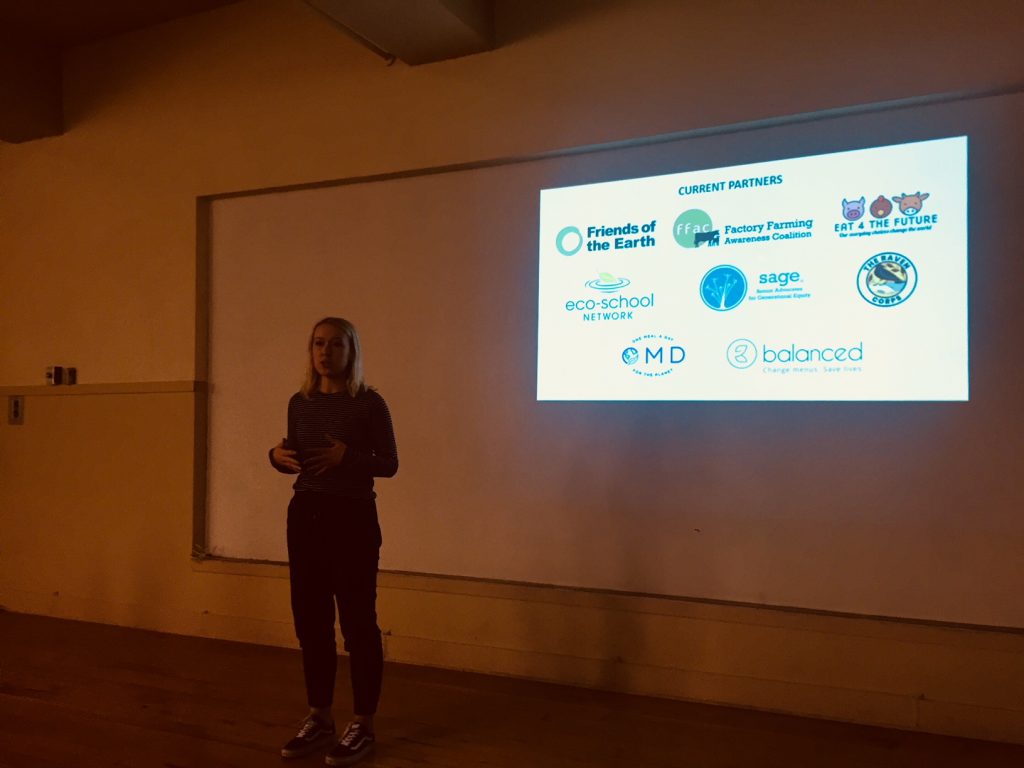Thank you to everyone who attended! I’ll have a separate post with the next steps. This is a recap of the forum for those who missed it. Last week we had a fantastic gathering with about 65 people attending, and many more who wanted to come. Our survey was taken by almost 250 people, most were parents and students. It was a fairly broad sample taken from about 50 schools. Out of the 90 Mt Tabor students, it was a cross-section of students who were not necessarily interested in vegan options.
Amy Hall (main parent organizer) started the evening talking about her personal story, the climate change implications, urgency and need for more plant-based options, as well as a vision of how Greener World Lunches can appeal to all students. Not only is this about climate change, but it is also about social justice. Students on Free and Reduced Lunch may eat a majority of their meals at school. If parents lack the time or money to supply them with healthy veg options, this especially impacts them. Here are a few paragraphs to share with those who weren’t able to make it.
Our youth understand this and in the face of inaction are striking around the world on Fridays, and demanding that leaders do something. As these students continue to learn about climate change, the plant-based options will become even more important to them. They will live with the consequences of what we do or do not do, right now. The longer we delay, the harder it will be for them.
On a hopeful note, a more sustainable world is definitely possible, but we will need to stop our current trajectory and make real changes to our system, quickly. Moving to a more plant-rich diet is one of the steps we need to take and something we can do every day. Just in the last couple of years, I have seen that the news and the environmental movement are finally acknowledging that intensive animal agriculture (factory farming) is a major contributor to climate change.”
In just the last 20 years, the 18 hottest years on record have occurred. Climate change is not in our future, it is happening now and progressing rapidly. If there is just one chart that shows the issue we face, it is this one:
Next, we had Brennan from Raven Corps speak about their organization and give student’s perspective.Raven Corps started as two clubs from Franklin and Cleveland but last year became a youth-based non-profit to support youth activists to advocate for a plant-based diet to help animals and the environment. It gives youth the opportunity to engage in the type of advocacy that they’re interested in and reflect back on what’s most effective.
They have hosted FFAC to give presentations to environmental groups, and have done vegan taste tests. They often hear comments about how students are interested in trying vegan food but it’s not accessible to them so having more access through school lunches would be really valuable. There’s a lot of excitement about helping the environment. Having options would be a great way to get people excited, especially if there’s education about how it’s good for the environment and good for people’s health.
Amy Higgs gave an overview on Eco-School Network. ESN is a great partner for Greener World Lunches as they have a broad network, support and resources for parents and students shaping sustainable schools. There are ESN parents and students in most of our schools who are involved in the cafeteria on different food waste, recycling, reusable silverware projects and more.
Next, Katie Cantrell, Factory Farming Awareness Coalition/Green Monday discussed how even one vegan meal a week makes a big difference.
My organization, FFAC, provides free presentations to schools, community groups, and businesses about the power of our food choices to help animals, the environment, and our own health. We are partnered with Green Monday, an international food sustainability initiative based in Hong Kong. I’m going to talk very briefly about the potent connection between food choices and the environment, and then provide some examples that have worked for other schools.
As the other speakers here tonight have done a great job of explaining, and as National Geographic summed up, “When we think about threats to the environment, we tend to picture cars and smokestacks, not dinner. But the truth is, our need for food poses one of the biggest dangers to the planet.” Eating less meat and dairy is the single most effective way that we can take action on a daily basis to help stop climate change, deforestation, air and water pollution, and a host of other environmental problems.
Young people are the ones who are going to have to bear the brunt of this, and we’ve seen an incredible movement of students here in Portland and around the world taking action to demand that the older generations leave them a habitable planet. We want to empower them so that they can take meaningful action on a daily or weekly basis with the support of their school and community.
Green Monday recognizes that for many people, the idea of going vegetarian or vegan overnight is overwhelming, and so people give up and don’t even try. Rather than presenting it as all or nothing, Green Monday encourages lots of people to work together to make small changes to their diet, adding up to a huge cumulative impact.
In Hong Kong, Green Monday works with 800 schools to offer plant-based meals to over 600,000 students.
In the US, we work with schools and businesses on both supply and demand. We work with dining services to ensure that one day every week (doesn’t have to be Monday), the featured special of the day is plant-based. We don’t advocate for removing meat from the menu entirely, because that tends to cause a backlash. Rather, we ensure that delicious plant-based food is available and use marketing to make it appealing.
To increase demand, we empower students to take this campaign on for themselves. They can encourage fellow students to pledge to go Green Monday by choosing that special option in the cafeteria. They can also do art contest, host cooking demos, have speakers, movie screenings, there are lots of ways to use this as a platform for education and empowerment around sustainable eating.
Then Chlöe Waterman from Friends of the Earth told us how other schools have successfully transitioned to more plant-based meals. Some of the Case Studies she referenced are here.
Lastly, Whitney Ellersick, PPS Nutrition Director spoke. She has kindly provided us her slides and permission to post them here: PPS-Presentation 5-20-19
Values and vision: Farm to school is huge, big interest in local purchasing. If you follow any of our activities we’re often talking about supporting farm to school bill efforts. OR was the first state to initiate and has put the most money towards it, which is very helpful to fund our purchases for school food. In 2016-2017, had $4.9 million in federal funding reinvested in the local economy. We also try to minimize the number of ingredients and make sure school lunches are for everyone.
I hear about the increase in satisfaction and participation and it warms my heart because it means students feel supported in choosing school food. There’s often a stigma that goes with it and our staff works very hard to make sure that it’s for everybody. A bill that just went through the legislature will expand our ability to offer free breakfasts and lunches and increase the poverty level to 300%. It’s huge, never been done in the country, it’s a very big move. Currently, 13 schools offer free breakfast and lunch to all students. If this goes through, looking at expanding to 36-40 schools starting in 2020.
What does local mean? Within 400 miles of Portland, includes OR, WA, NorCal, and Western Idaho. Where does the money come from? None of it comes from PPS general fund, comes entirely from federal reimbursement from USDA. They provide $3.39 for each free and reduced meal and 39 cents for each paid lunch sold. That includes all of the ingredients, labor costs, supplies, everything. We have a central distribution site. All the partners we purchase from deliver to one site. Then we have a team of 9 drivers and warehousemen that deliver the ingredients for the next day or two’s menu. One of our initiatives is to reduce delivery as much as possible to reduce carbon footprint, so most sites will get delivery every other day.
Equipment: The team only has ovens to prepare food in. Most equipment is old from 1950s off of WWII ships. Trying to replace it so that they’re able to do more effective cooking and better quality cooking. With new schools they’re able to add new equipment that’s safer to use but requires training over time. Most kitchens have warmer for holding hot food after it comes out of the oven and a service line. Some sites have sinks, some have dishwashers. That varies from site to site. One of the things that’s been limiting is the electrical capacity loads. I’m having to figure out what equipment I can keep in the Llewellyn kitchen because they have a low electrical availability. Some of those limitations that we have to work with are not apparent or visible.
Environment – we’re talking about a very short period of time to feed a lot of kids and have kids eat lunch. That’s really taken effect because of the pressure for academic time during the school day. We’ve seen a reduction in the time allocated to eating and enjoying meals together. That’s a hard one for us to navigate because we’re often told to have the kids come through the line quicker. We can get 12-15 kids per minute but we’re asked to speed it up. Depending on the size of the cafeteria, sometimes we can only fit one grade at a time. My team doesn’t always have the amount of time to interact as much as they would love to with all of their students. That’s the number one feedback we get from families is not enough time for lunch, and unfortunately, that’s not something I can control. Each principal sets their own schedule, and there’s so much they’re trying to navigate. That impacts food waste, when students are eating on the way to the garbage can.
Local suppliers: Finding suppliers is always a challenge. We had this great hummus meal but the hummus producer is no longer supplying K-12, so we have to look for new hummus supplier. That’s one challenge we’re facing.
Purchasing rules from the federal government: Because they have so many meals we’re serving, we have to do formal procurement and bid process that takes longer.
New this year: Added lentils to the menu in February. In a pasta dish as a protein source, and served a lentil salad. In January revisited the Indian curry and had garbanzo beans instead of chicken. That was our focus this year, to have a local option be plant-based in January and February. In the past, the local lunch has usually focused on meat and/or fish. Offered at every school.
Most recently, had a new menu item out of Richmond Elementary with yakisoba with organic, locally-produced, women-owned business providing the yakisoba. We talked about the fact that we really want to blend the excitement with culturally-relevant food. We have a very diverse community that can offer up recipes that are naturally plant-based and have good flavor.
Also, have been trying to highlight mushrooms over the last several years on the menu. They’re organic and out of Oregon, have had them in salads and on pizza, trying to expand student palates.
Challenges: One hiccup I’m trying to navigate is regulations around beans. In the USDA world, beans can be either a vegetable or a meat alternative. But they can’t be both on the same day. I have to navigate because I’m required to have beans as a vegetable weekly on the menu. On the same day, I can’t serve beans as a protein in a vegetarian or vegan dish. One of the things to navigate is how to plan that out and meet the requirements, otherwise, we won’t get the reimbursement. If students take 4 carrots instead of 5 we have to give back money. It’s for real, that’s the level they look at. If you hear me hem and haw, it’s because I’m trying to navigate all of these requirements and regulations.
It wasn’t until a couple of years ago that I was even able to purchase tofu. Prior to that, it was not a recognized food according to the USDA child nutrition program. It’s a great equity and diversity conversation for sure. Just last week I got a memo about how to credit tempeh. So we’re getting there but we have to have the backing for that in order to get funding from USDA.
How we can help:
- Parents and others supporting school meals, it’s amazing what that means to other students who participate in school meals. If students hear adults saying bad things about school food or school meals they’ll choose not to eat or make different choices. It makes a lot to have the backing and have students feel they have support for good food choices.
- One of the things that’s very helpful is being able to have adults in the cafeteria to allow students the chance to taste the foods, either before or while they’re standing in line. There’s so little time that it makes it less risky if they can sample the food first before they choose it.
- Spend time at the schools (with permission), either just to see what it’s like or working in the cafeteria. Experience it, then give me some of the honest feedback about what you experienced and saw.
- Advocate at the state and national level for child nutrition reauthorization. Write your congressman. The more parent voices we have behind what we want to see in school meals helps. In particular, Suzanne Bonamici is chair on that and she’s been very good at listening to what works and what doesn’t. On a national level, that’s huge. There’s always a threat to school meal funding, particularly when there’s talk about block grants. The more students choose lunch, the more I can do.
- Local partnerships. Have had partnerships with slow foods and Growing Garden and OSU Extension snap services to bring in samples of different vegetables to get them to try new foods and be more adventurous. Stuff my team doesn’t have the time or capacity to do as much as they would love, so that’s where it takes these partnerships to make it happen.
Q. When it comes to cost, meat and dairy are subsidized and fruits and veggies are not. How does that situation affect serving non-dairy and non-meat foods?
A. Within child nutrition programs right now, I have access to over 200 foods, so they’ve expanded it. Includes garbanzo, black, pinto beans, PB, other vegetarian protein sources, as well as fruits, vegetables, and grains. One of the limitations that still exists is the distribution of that food. Because OR is such a small state, we have to fill a truckload of that food item in order to get it here. That limits us to about 30 common items out of those 200. What I would like to have doesn’t always match with what my colleagues at other OR school districts would like to have. USDA is working to change how they distribute the foods. That’s a shortfall because CA can order tons of truckloads of items because they’re a larger state with larger truckloads of items. But we do have access to things outside of meat and dairy. That’s why it can take 1-3 years to roll out a new recipe district-wide. Local procurement is a two-year conversation. It took 2 years of conversation until farm to school funding came through to buy local ketchup.
One thing that concerns me right now is tracking weather impacts on food purchases. Floods in the midwest are delaying planting of legumes, so that might mean delayed sourcing or increased costs for beans.
Q. Is there a way to creatively restructure how you put the ingredients together so that there’s a way to serve at least one plant-based option without adding new options? My son for medical reasons cannot eat dairy, and all of the vegetarian options have dairy in them. If there were a way to take the pasta dish and remove cheese and add chickpeas, that could be a more immediate and practical thing to make change while working on the bigger picture.
A. That was the play with the lentils. Definitely work with my team because we should be able to work with you to make appropriate substitutions if you have a student with allergies.
Q. Is it true that students have to take milk with school meals?
A. No, that’s not true and has never been true
Q. What about soy milk?
A. Right now the district only allows Pacific plain soy milk as the only acceptable meat substitute, and also lactose-free milk. That’s all that I’m able to work with right now. We have tried serving soy milk as an a la carte option years ago but it was not as popular because it was plain.
Q. Could Green Monday be a reality in the near future, as a stepping stone towards more plant-based?
A. One thing that’s hard to capture is the variety of programs we’re responding to. We menu throughout the week, and we try to look at where can we plug in the variety of options throughout the week. From a school standpoint, could be a particular school or community initiative, but not one that I could promote from a district standpoint. I try to menu things that match these various initiatives so that students can take this on themselves.
Q. We worry about other types of waste, like plastic. Don’t understand why it’s falling on parents, seems like an education opportunity. Is there overlap between nutrition services and curriculum?
A. Ties into work with Betty. NIH grant submission is specifically trying to integrate food waste into STEM electives, first targeting middle school. Integration both studying food waste in cafeterias and in the home with teachers providing an avenue for students to explore research-based questions about what that looks like for them in their environment. That would be the first time that we’ve had that type of integration. It’s often something that comes out of our district, we tend to work in a siloed environment. Really excited about this opportunity, learning a lot about the academic world. Becoming a behavior that’s embedded in the culture of our schools is so much richer and hopefully can carry through as students advance in each grade.
Q. Want to acknowledge and appreciate the creativity in the menu and the fact that you still serve whole grains. I’ve worked at different schools and they’re such different experiences that it’s amazing to me that it’s the same system. You mentioned that the equipment and school culture are different. Is there a way for the kids to give feedback so that they feel more empowered? Just takes a few bad experiences for students to stop choosing school lunch, especially when it’s free because then they’re not valuing it.
A. We love to get feedback from students. Students will often say bad things about the food before you can say it. At high schools, when school lunches are free they saw participation go up to 50% even though they have open campus policies. I met with Alliance High School at Meek, so they can tell me what they do like and want to see more often and what doesn’t sustain them through the day.
Beyond the Richmond cultural events, we also did it at Woodstock and we’ve done 2 events at George. Did Hispanic cultural, and black history month. PPS let them choose what foods they wanted to serve.
Q. How can students give feedback?
A. The easiest way is via email, all contact info is listed on the website, also have nutritionservices@pps.net
So many different avenues, have done focus groups on select food items, have done other feedback forums like surveys at certain schools, trying to tailor it to what the students are doing so there’s a presentation coming up on plastic in school meals.
Q. Parent and pediatrician at Bridlemile, have been trying to get parent-sponsored salad bar. Do you have any type of pathway or plan on how PTAs can get salad bars installed?
A. We’ve had salad bars since 1995 and always offer unlimited fruits and veggies with them. In 2012 there were new regulations rolled out. One was that students had to select a ½ cup of fruits or veggies for their meal and all of that had to happen before the point of sale. Most of the salad bars were out in the cafeteria, after the cash register. During that time, we also had health inspectors tell us that we needed to get rid of the physical salad bars because it was a safety hazard. So we’ve transitioned to having all of the fruits and vegetables in the service line along with the entrees as part of the actual service line. We’ve found a reduction in waste where it’s moved onto serving line because they can keep them restocked but not too much so that it’s creating waste at the end of the day. That’s in transition in all sites to move away from a physical salad bar.
Q. Was there a change in the amount of fruits and veggies taken?
A. No, not really. We haven’t seen so much a decrease in consumption, more a decrease in the amount of waste that’s being produced. Always exceed the number of fruits and veggies required of us, and always offer unlimited as part of our meals, it just might look different.
Q. Who’s the decision-maker on using reusable plates?
A. In middle school, reusable is a little tricky. Elementary is easier because they’re a captive audience, they only eat in the cafeteria, raise your hand to get up, etc. In middle school, kids eat in various locations throughout the school. When we first piloted the reusable trays they would go missing and not make their way back to the cafeteria. Or there was less coordinated effort to separate and stack trays and silverware. One of the conversations is how do we change what sustainability looks like with plastic use in middle and high schools because they’re larger populations that are less regulated. Don’t want to buy those options only to see them thrown away and disappear. Nutrition services makes the decision as to whether or not a school has reusables. To date it’s a community initiative to do a silverware drive, if they have it they’ll wash them and use them.
Q. With Green Monday, you said to get involved at the school level but if all of the food is coming from central distribution, how can we decide by school?
A. What hopefully will come out of this, what I need help knowing, is what to add on to our menu. How the menu gets shaped takes time, making a bunch of changes on our menu can cause fights and boycotts if it’s done too quickly. Because I’m federally funded and asked to be part of a lot of initiatives I have to be careful about which ones I sign onto. From a community standpoint, I can help build menus that allow schools to take place in their initiatives. Having that voice helps me know how to better meet the needs of the community.






